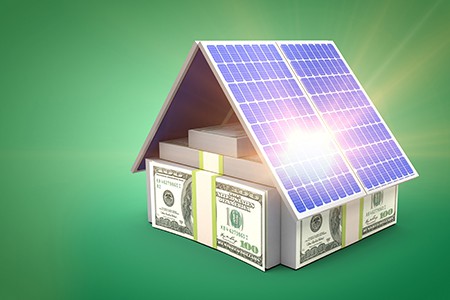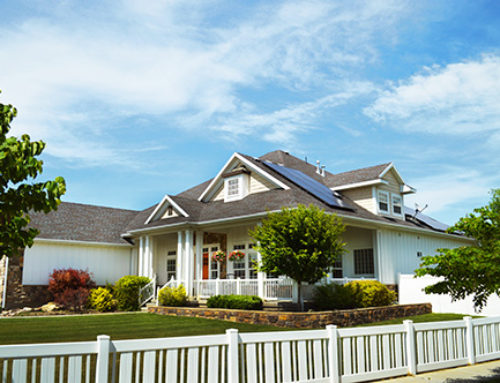Solar energy investment is a great way for you to generate your own power using the sun.

Renewable technologies allow you to lower your carbon footprint and use natural sources to provide light, heating and cooling for your home. If you live in a large wide open rural area with plenty of sunlight, solar energy makes even more sense.
While eco-friendly technologies are a great long-term investment, they might be prohibitively expensive to set up. Thankfully, the government and non-profit organizations offer a number of solar energy grants to asset with the transition.
This is your Guide to Solar Energy Grants, including FHA Loans, VA Energy Efficiency Mortgages and Solar Share Cooperatives.

Solar Energy Grants
Did you know that there are nearly 301 million homes in the United States? If every house was retrofitted with solar panels, then the country’s energy supply could be greatly augmented. According to CNBC, there are 1,300,000 solar installations in the United States, generating a total of 40 gigawatts.
The Solar Energy Industries Association has calculated that this 40 gigawatts can power 6,560,000 households. Based on these figures, if 1 out of 5 Americans added solar panels, they could power the entire country. But so far, it has taken several government grants and tax incentives to reach this milestone.
Since energy is a communal good, the entire country will benefit if homeowners transition to eco-friendly energy sources. The United States can have a more efficient electrical power system. Power companies can lower their costs due to increased efficiency.
Due to the communal benefits of installing solar panels, storage batteries and so forth, the government offers a number of financial incentives for people to make the switch. The installation, maintenance and service of solar systems can be expensive.
But, because of the following advantages of solar energy, the government will help you financially:
- Energy Independence
- Job Creation
- Clean Energy Power
- Lower Carbon Emissions
- Increased Energy Efficiency
The United States will become more energy independence, not needing to import as many fossil fuels. Green energy firms can hire more employees, which will create more jobs. This could help boost the economy.
Mother Nature will be improved with better air quality for all. There might be fewer cases of asthma due to smog.
Overall, energy efficiency levels will rise, which creates a more efficient power grid. Fewer new power facilities will need to be built and the saved money can be invested on other things.

Financial Assistance Types
There are many ways that the federal, state and local governments can provide financial help to those transitioning from fossil fuels to renewable energy. Start with the 30% Federal Investment Tax Credit for solar systems. You might want to research solar power government grants at the Office of Energy Efficiency & Renewable Energy. Search under the “Renewables” category and “Solar” sub-topic to find what you need.
Governments grants vary dramatically across the country. Some of the Western states might provide you with more assistance in “going green.”
These are the 3 primary ways in which you can raise money for solar energy equipment investments:
- Grants
- Loans
- Mortgages
Solar power government grants are free – you don’t need to pay them back. Usually, the qualifications are based on your income level, location or ethnic background. Technology nonprofit organizations have different social goals.
Loans must be paid back. In general, the government will guarantee a certain percentage of loans, which are financed by private lenders.
Eco-friendly mortgages combine housing financing with a rebate for turning it into a green home. Upgrading home renewable energy systems might require you to prove that there is a higher energy efficiency use after the work has been done. The concept behind these green energy mortgages is the Home Equity Line of Credit (HELOC) – improving the value of your home by upgrading the features.

Solar Energy Share
Communities can also pool their financial resources under solar energy share cooperatives. The community uses its money to invest in large solar generation farms. Sometimes, this is the most efficient clean energy power system because the facilities can find large, wide open spaces that receive a lot of sunlight.
How does this system work? Basically, members subscribe to the solar cooperatives by paying dues. Once the solar generation farms are fully functional, members can purchase cheaper energy from the farms than would be available from utilities. Typically, the solar energy share subscription rates are locked in for long periods of time (i.e. 25 years or so).
FHA Loans
The Federal Housing Administration (FHA) PowerSaver program provides home improvement loans for solar system installation. The FHA PowerSaver Program places a second mortgage on your home for retrofitting.
These are the characteristic of this solar energy retrofit loan:
- Up to $25,000
- 7 to 20 Years
- FHA 203(k) First Mortgage
- Credit Score of 660
You must already have an FHA 203(k) first mortgage to qualify for this program. Also, this program varies by state, so you will need to see if your state is included.
VA Energy Efficiency Mortgages
The Department of Veterans Affairs (VA) Home Loan Guarantee Program pays for installation of solar cooling and heating systems. VA Energy Efficiency Mortgages provide between $3,000 and $6,000 for installation or upgrades to solar water heaters or solar heating systems. Homeowners must show that the estimated savings from energy efficiency use will be higher than the rise in monthly mortgage payments.
In general, the VA Home Loan Guaranty Program is very popular because it provides 100% financing with a 0% down payment. Even if veterans have below average credit scores, they still might qualify.

Technology Nonprofit Organizations
There are a number of technology non profit organizations that use green energy funding to achieve their community goals. These might be aimed at groups of people or energy efficiency goals. Nonprofits organizations can provide both logistical and financial assistance for retrofitting building with renewable energy systems.

Solar Net Metering
Once home renewable energy systems are installed, the local power company will use solar net metering to determine your bill. Your home energy production will be subtracted from your home energy usage. Clean energy power net metering could dramatically lower your monthly energy bill.

Rural Renewable Energy
Of course, some areas receive more sunlight than others. Those places with few trees or buildings might be able to optimize their solar energy production.
Rural sustainable energy investment might enable small, dispersed towns to upgrade their facilities. They could install more light poles and keep the community center open for longer periods of time. Of course, it can be challenging for small towns to have sufficient energy when they are far from power plants.
Fortunately, governments grants can help raise the standard of living of these small towns. Organizations, such as the Rural Renewable Energy Alliance (RREAL) assist with the growth of rural renewable energy systems. Special rebates might be available.
Some small rural communities are seeing their young people move to the big cities, which have plentiful electricity and attractive features. By supporting renewable technologies, some rural communities might be able to keep their young people. They can use sustainable energy to support sustainable community growth.
